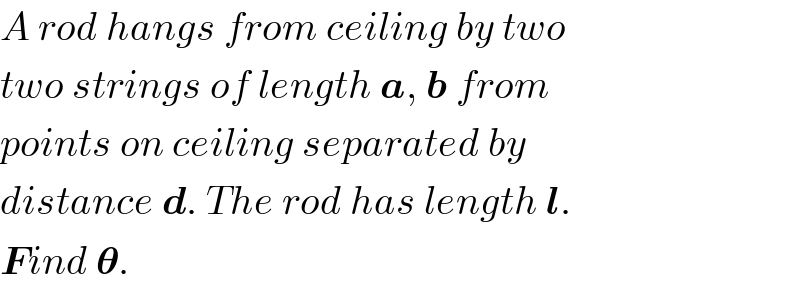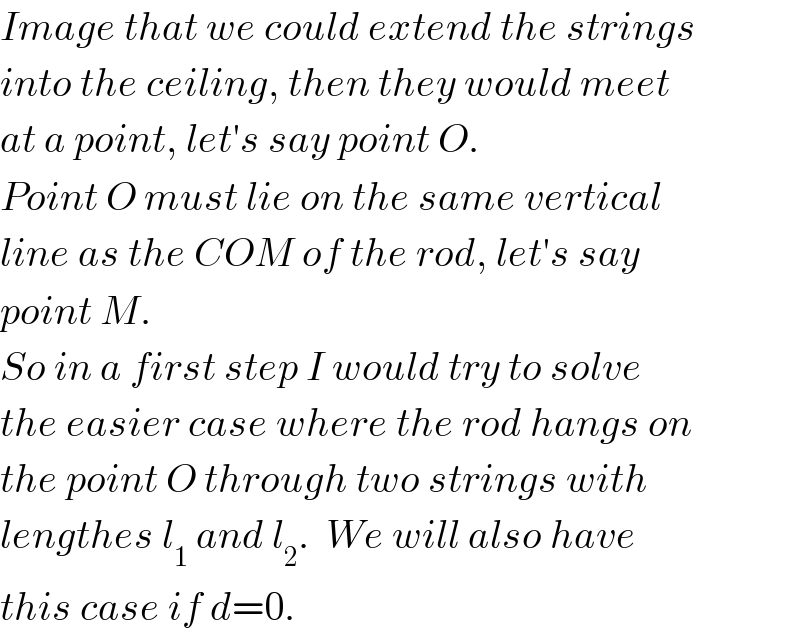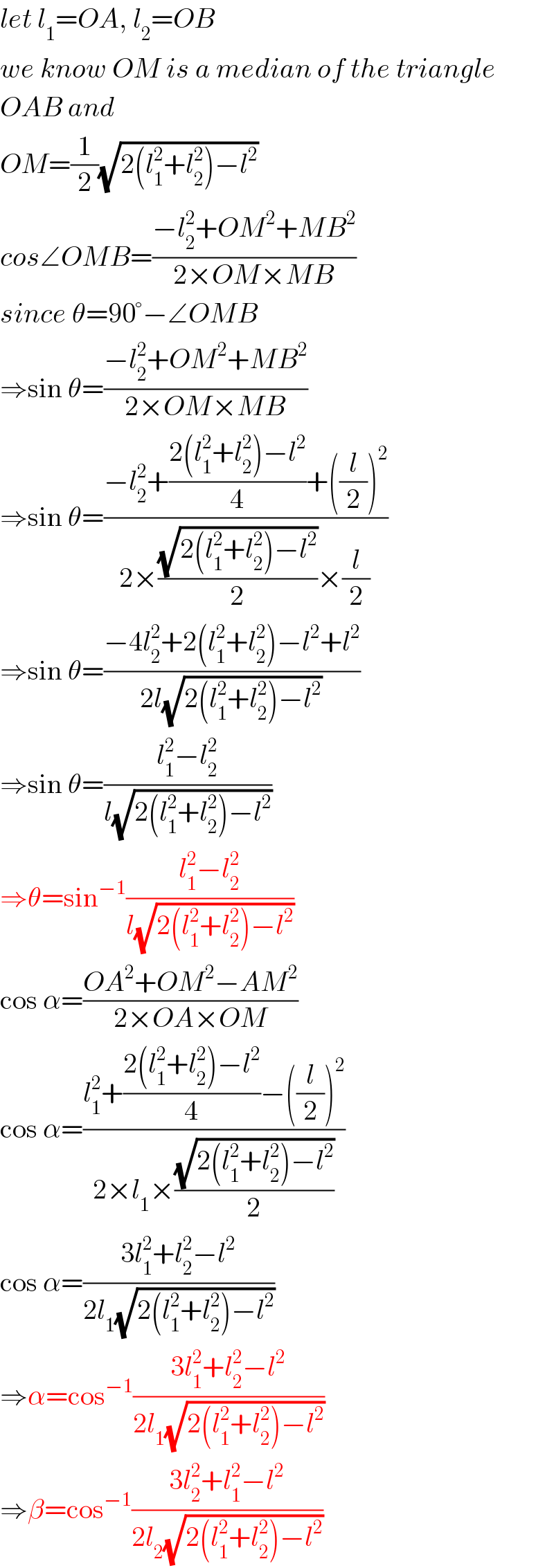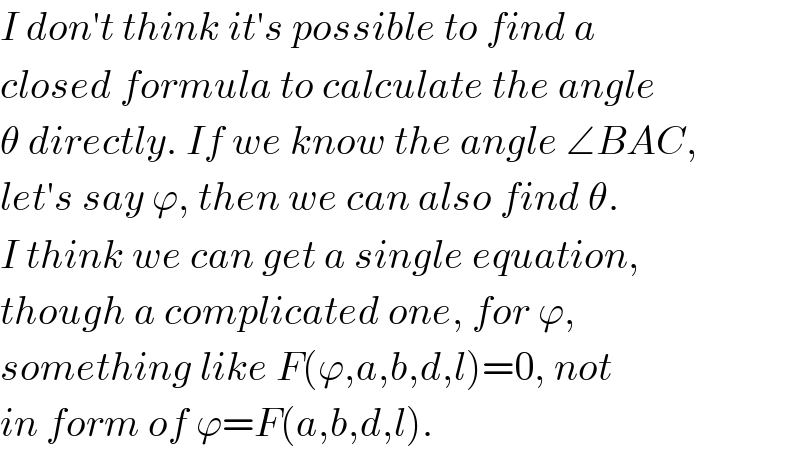
Question and Answers Forum
Question Number 38094 by ajfour last updated on 21/Jun/18

Commented by ajfour last updated on 21/Jun/18

Commented by MrW3 last updated on 23/Jun/18

Commented by MrW3 last updated on 23/Jun/18

Commented by MrW3 last updated on 23/Jun/18

Commented by ajfour last updated on 23/Jun/18

Commented by MrW3 last updated on 23/Jun/18

Commented by ajfour last updated on 23/Jun/18

Commented by MrW3 last updated on 24/Jun/18

Commented by ajfour last updated on 24/Jun/18

Commented by ajfour last updated on 24/Jun/18
![{ d_1 +acos α=(l/2)cos θ }×tan 𝛂 {d_2 +bcos β =(l/2)cos θ }×tan β Since d_1 tan α = d_2 tan β =h asin α−bsin β =(l/2)cos θ(tan α−tan β) Now asin α−bsin β = lsin θ _____________________ ⇒ tan 𝛂−tan 𝛃 = 2tan 𝛉 _____________________ Considering the △ with sides a, b, and ρ we have (ρ/(sin (α+β)))=(a/(sin (β+δ)))=(b/(sin (α−δ))) α=sin^(−1) [((bsin (α+β))/ρ)]+δ β=sin^(−1) [((asin (α+β))/ρ)]−δ where (as can easily be seen) 𝛒^2 =(lcos 𝛉−d)^2 +l^2 sin^2 𝛉 tan 𝛅 = ((lsin 𝛉)/(lcos 𝛉−d)) cos (𝛂+𝛃)=((a^2 +b^2 −𝛒^2 )/(2ab)) sin (𝛂+𝛃)=(√(1−[((a^2 +b^2 −𝛒^2 )/(2ab))]^2 )) ρ^2 −b^2 sin^2 (α+β)=ρ^2 −b^2 +(((a^2 +b^2 −ρ^2 )^2 )/(4a^2 )) =((4a^2 (ρ^2 −b^2 )+[a^2 −(ρ^2 −b^2 )]^2 )/(4a^2 )) =[((a^2 +ρ^2 −b^2 )/(2a))]^2 ⇒ 2absin (α+β)=(√(4a^2 b^2 −(a^2 +b^2 −ρ^2 )^2 )) ⇒bsin (α+β)=((√([(a+b)^2 −ρ^2 ][ρ^2 −(a−b)^2 ]))/(2a)) ________________________ 2tan 𝛉 = tan α−tan β =tan {sin^(−1) [((bsin (α+β))/ρ)]+δ} −tan {sin^(−1) [((asin (α+β))/ρ)]−δ} =tan {tan^(−1) (((bsin (α+β))/(√(ρ^2 −b^2 sin^2 (α+β)))))+𝛅} −tan {tan^(−1) (((asin (α+β))/(√(ρ^2 −a^2 sin^2 (α+β))))−𝛅} __________________________ 2tan θ =tan [tan^(−1) ((√([(a+b)^2 −ρ^2 ][ρ^2 −(a−b)^2 ]))/(a^2 +ρ^2 −b^2 ))+δ] −tan [tan^(−1) ((√([(a+b)^2 −ρ^2 ][ρ^2 −(a−b)^2 ]))/(b^2 +ρ^2 −a^2 ))−δ] ___________________________ .](Q38363.png)
Commented by MrW3 last updated on 24/Jun/18

Commented by ajfour last updated on 25/Jun/18

Answered by ajfour last updated on 24/Jun/18
![2tan θ = tan {tan^(−1) [((√([(a+b)^2 −ρ^2 ][ρ^2 −(a−b)^2 ]))/(a^2 +ρ^2 −b^2 ))]+δ} −tan { tan^(−1) [((√([(a+b)^2 −ρ^2 ][ρ^2 −(a−b)^2 ]))/(b^2 +ρ^2 −a^2 ))]−δ} where 𝛒^2 = l^2 sin^2 𝛉+(lcos 𝛉−d)^2 and 𝛅 = tan^(−1) (((lsin 𝛉)/(lcos 𝛉−d))) .](Q38352.png)
Commented by ajfour last updated on 24/Jun/18

Commented by MrW3 last updated on 24/Jun/18

